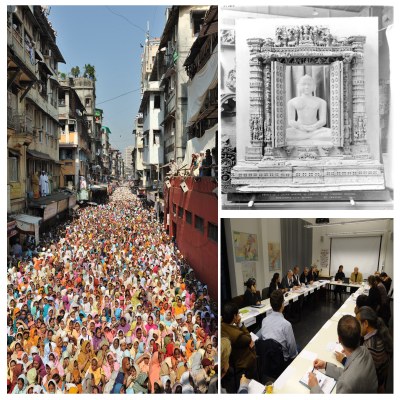Südasien-Chronik 2015(5): South Asia and the World Wars in the Twentieth Century
Das neue Online-Journal "Südasien-Chronik" ist eine seit dem Jahrgang 2011 einmal jährlich erscheinendes Online-Journal. Es ist ein sozial-kulturwissenschaftliches Organ, in dem Themen zu allen Staaten in der Region Südasien (Indien, Pakistan, Afghanistan, Bangladesch, Bhutan, Malediven, Nepal, Sri Lanka) berücksichtigt werden. Die "Südasien-Chronik" beschäftigt sich mit einem breiten Spektrum von Fragen, u.a. zu Umwelt, Sport, Migration, Gender sowie Medien und Literatur. Besondere Beachtung finden dabei internationale und transregionale Aspekte. Jeder Jahresband hat einen Themenschwerpunkt. Die Schwerpunkte berücksichtigen kulturelle, gesellschaftliche, wirtschaftliche und politische Themen von gegenwärtiger oder historischer Bedeutung. Beiträge mit aktueller oder besonderer Relevanz, die außerhalb des jährlichen Themenschwerpunktes liegen, finden ihren Platz im "Forum". Jeden Band schließt die Rubrik Forschungsberichte ab.
Kontakt
E-Mail: southasiachronicle@hu-berlin.de
Bände und Themenschwerpunkte
2015(5) South Asia and the World Wars in the Twentieth Century
During the two World Wars ‘aliens’ of all skin and eye colours, linguistic groups, cultures and faiths were brought to Europe in the form of colonial soldiers and Black Americans who fought for the Allies. Among them were Africans, Egyptians, Turks, Palestinians, Arabs, Indians (from British India), and so on. To remember these ‘strange foreigners’, this year’s FOKUS of the South-Asia Chronicle deals with a specific category of these temporary soldier-migrants who were brought to Germany in thousands as captive British-Indian soldiers and camp followers in World War I and World War II. Some of them died in various prisoners of war (POW) camps, sick bays, hospitals, and sanatoria, others survived their ordeals in captivity in various internment camps or Stalags (Stamm-lager, i.e. large POW camps).
Each essay of FOKUS showcases a different range of archival deposits in various parts of Germany – in isolated cases also from Britain, India and Geneva – which has been used to recreate the lived experiences of ‘alien coloured captives’. All of them in their own ways allude to the dilemmas, anxieties, and confusions that the German officialdom faced during the two World Wars. Within this short span of time, the authors have outlined phases into which the treatment of jangi qaidis could be divided notwithstanding continued cultural confusions and linguistic misunderstandings.
The FORUM of the volume includes seven articles on diverse topics from history, sociology, and anthropology. The final rubric REVIEW ESSAYS contains contributions that present state-of-the-art and historiographical overviews on various topics.
Inhalt
Editorial
Focus |
Joshi, Vandana |
South Asia and the World Wars in the Twentieth Century: An Introduction |
|
Lange, Britta |
„Wenn der Krieg zu Ende ist, werden viele Erzählungen gedruckt werden.“ Südasiatische Positionen und europäische Forschungen im „Halbmondlager“ |
|
|
Koller, Christian |
Deutsche Wahrnehmungen feindlicher Kolonial¬truppen im Ersten Weltkrieg |
|
|
Roy, Franziska |
Indian Seamen in World War I Prison Camps in Germany |
|
|
Kuhlmann, Jan |
Die Indische Legion im Zweiten Weltkrieg: Interkulturelle Menschenführung zwischen Atlantikwall und Wehrmachtsgefängnis |
|
|
Oesterheld, Joachim |
The Last Chapter of the Indian Legion |
|
|
Joshi, Vandana
|
Between Erasure and Remembrance: Shreds from the Lives of South Asian Prisoners of War in Stamm¬lagers, Arbeitskommandos, Lazaretts and Graves During World War II (1939-45) |
|
|
Nagel, Jürgen |
Asien und der Zweite Weltkrieg. Gedanken zur »anderen« Seite eines globalen Krieges
|
|
Forum
|
Popp, Silvia |
Altern in Indien: Die Familie und der Staat als Überlebenshilfe |
|
Wilhelm, Janine |
Indiens koloniales Erbe der Flussverschmutzung |
|
|
Hesse, Patrick |
Communism and Communalism in the 1920s. Notes on a Neglected Nexus |
|
|
Paranjape, Swarali |
Tools of Satire: Marathi Theatre in Colonial India. The Case of Sangeet Sthanik-Swarajya athva Munici¬pality |
|
|
Sengupta, Anwesha |
City Calls to City Walls: Pheriwallah/wallihs and the (Un)contested Spaces of Kolkata |
|
|
Nejad, Reza Masoudi |
Urban Margins, a Refuge for Muharram Processions in Bombay: Towards an Idea of Cultural Resilience |
|
|
Schröder, Johannes |
A Wooden Jain House Temple from the Berlin Museum of Asian Art and its Tradition
|
|
Review Essays |
Herklotz, Tanja
|
Religion-Based Personal Laws in India from a Women’s Rights Perspective: Context and some Recent Publications |
| Bondada, Gautam |
The Role of Monetary Networks in the Trade between India and the Roman Empire |
|
|
Surendran, Aardra |
Studying Labour Culture in India: The Missing ‘Everyday’ of Industrial Work |
|
|
Mann, Michael |
Slaving, Slavery and Abolition: A View from the Indian Ocean. Notes on Some Recent Publications |
|
|
Bajpai, Anandita |
Report on the Inaugural Workshop of the DFG-funded project ‘Modern India in German Archives, 1706-1989’, ‘Das Moderne Indien in deutschen Archiven, 1706-1989’ (MIDA) |
|
|
Merkel-Hilf, Nicole |
Ausbau des asienwissenschaftlichen Informationsangebots - CrossAsia – Fachinformationsdienst Asien geht an den Start |
Link to the 5th edition of the South Asia Chronicle


